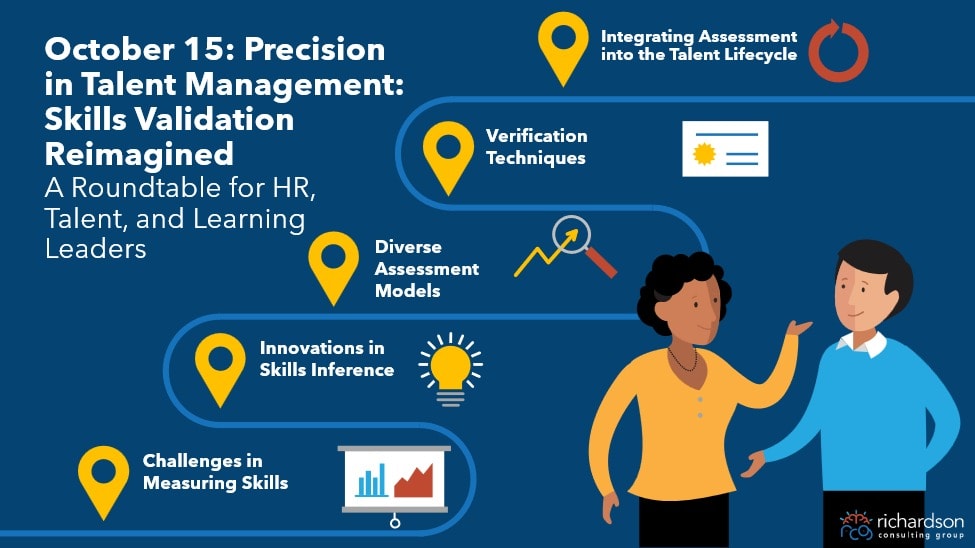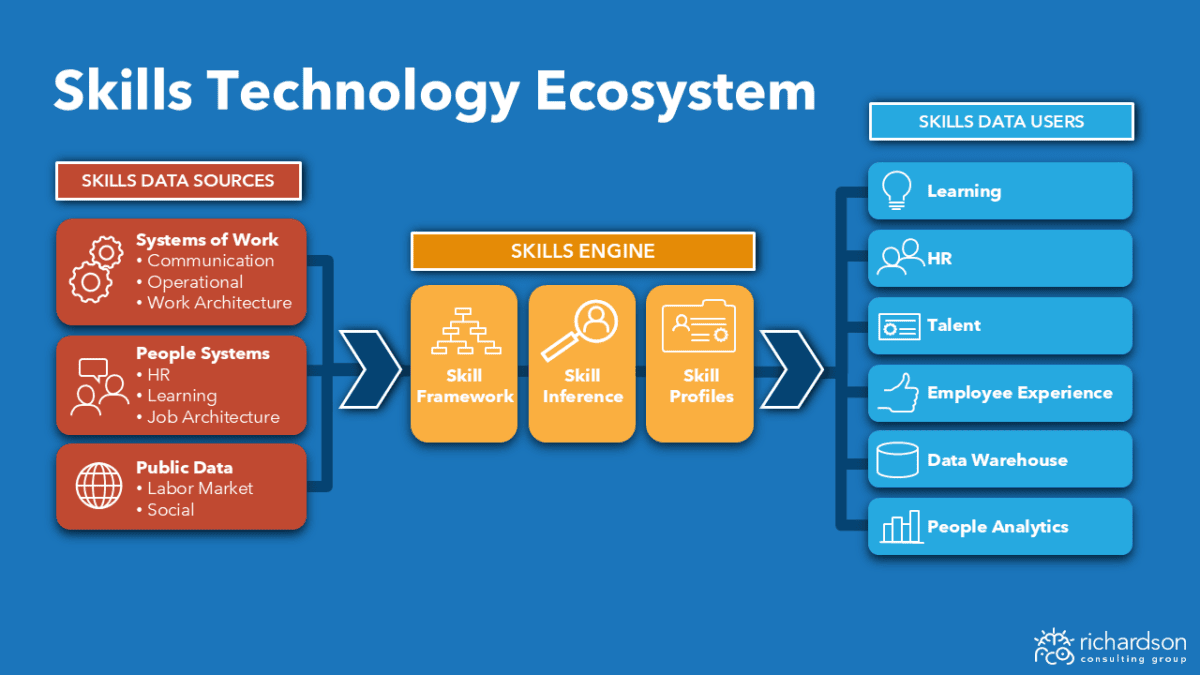
Skills validation is how organizations verify the skills people actually have—so learning, mobility, hiring, onboarding, performance, and workforce planning can rely on real data instead of guesswork. As more orgs shift to skills-based talent practices, clean, continuous, human-verified data becomes the difference between pilots that stall and programs that scale.
How skills data actually flows
Figure 1: The Skills Data Ecosystem
Skills signals originate from systems of work, people systems, and public data sources, then flow through a central skills engine (skill/work frameworks, inference, profiles) to power HR, Learning, and Talent systems. This flow enables accurate validation, personalized experience, and analytics.

Key themes & insights
- Self-assessment dominates—scaffold it.
It’s the lightest lift but prone to bias and avoidance. Anchor updates to goal-setting, midyear, and performance conversations (even when not used for ratings) to keep profiles fresh. - Use the right validation method for the skill.
- 360s for leadership behaviors and influence.
- Simulations, observations, and formal assessments for task, safety, or customer-critical skills.
- Lighter checks or peer inputs for low-risk, ubiquitous skills.
- Balance rigor with effort.
Adoption rises when the first ask is small and value shows up fast (e.g., repeat a 360 in six months and show movement). - Don’t mix purposes too soon.
If data fuels development, use growth-oriented scales and messaging. If it informs evaluation, use clear performance scales and governance. Blending too early confuses and erodes trust. - AI inference is additive, not authoritative.
Treat inferred signals as drafts that employees review before they land on profiles. Keep humans in the loop and test outcomes with your vendor. - Executive pull accelerates everything.
Succession planning and workforce planning create leader visibility—and demand for better data—fast-tracking governance and investment.
Real-world practices from the community
- Show progress, create pull. Brad (TVH Parts Co) repeats FranklinCovey 360s across 38 competencies; visible growth drives buy-in and participation.
- Assess applied skill, not trivia. Ben (Degreed) highlighted assessments that ask, “Have you taught it? Solved with it?”
- Build a universal skills backbone. Allie (Providence) runs monthly workshops on five core skills, paired with community discussion to fuel positive opt-in.
- Wire skills into succession. Shirish & Jessica (Dow) align role profiles, sanity-check with market sources, bucket core vs. emerging, and feed leadership conversations.
Common barriers (and how to sidestep them)
- Bias & fear of misuse → Publish a data-use statement; let employees control what lands on profiles.
- Rubric paralysis → Start with presence/absence or simple tiers; add proficiency later.
- Assessment fatigue → Show value quickly (trend lines, before/after) and limit time and cost to what risk justifies.
A pragmatic playbook you can use this quarter
- Decide the purpose (development or evaluation) and say it out loud.
- Start small with a few critical roles/skills; keep the first experience under 15–20 minutes.
- Make updates habitual by tying them to existing milestones.
- Mix methods by risk: simulations/observations where error is costly; self+manager+evidence elsewhere; inference as a draft.
- Give leaders ownership: ask each function to sponsor one skill month (e.g., AI literacy, InfoSec).
Practitioners in their own words
- Brad, Talent Development – Americas, TVH Parts Co: “The second 360 is when adoption jumps—leaders see real movement, and participation follows the proof.”
- Ben, Director of Skills & Talent Strategy, Degreed: “We focus on applied experience—have you taught it, solved with it?—instead of trivia.”
- Jessica, Sr. Talent Management Manager, Dow: “We’re choosing progress over perfection while keeping fairness and trust front and center.”
- Shirish, People Analytics COE Leader, Dow: “Define how skills data will be used and weave it into processes—otherwise people stay in the dark.”
- Allie, HR Program Manager, Providence: “Five universal skills, one workshop a month, and a community space—it’s a simple way to create pull.”
Complimentary next step: Skills Readiness Snapshot (45 minutes)
Benchmark your current state across six capabilities (Culture; Partnerships & Governance; Data; Architecture; Analytics; Technology), identify 2–3 immediate next steps, and receive a leader-ready briefing to win executive buy-in.
We use this same starting point with global clients before larger strategy engagements. It’s complimentary for our roundtable community.
